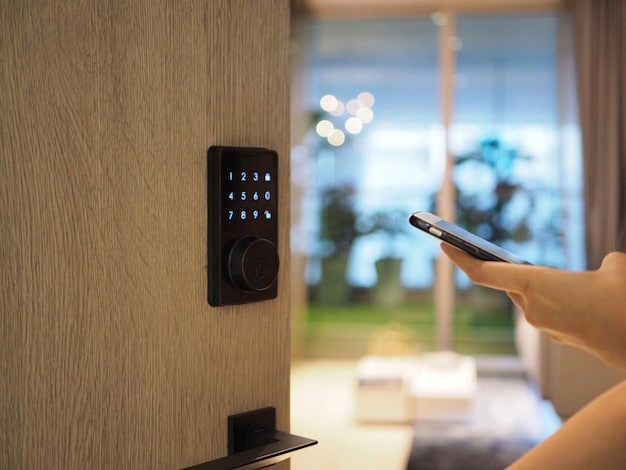IoT Security Concerns: Protecting Your Network from Connected Devices

IoT Security Concerns: Securing Your Network from Vulnerable Internet-Connected Devices is crucial in today’s interconnected world, addressing risks like data breaches and unauthorized access to IoT devices.
In today’s interconnected world, the proliferation of Internet of Things (IoT) devices has revolutionized various aspects of our lives, from smart homes to industrial automation. However, this increased connectivity brings significant IoT Security Concerns: Securing Your Network from Vulnerable Internet-Connected Devices, posing unprecedented challenges for individuals, businesses, and governments alike.
Understanding IoT Security Concerns
The exponential growth of IoT devices creates a vast attack surface for malicious actors. Understanding where these vulnerabilities lie is the first step in mitigating the risks.
The Expanding Attack Surface
Every connected device represents a potential entry point for cyberattacks. The more devices on a network, the greater the risk.
Legacy devices, often lacking security updates, can serve as backdoors for hackers. A single compromised device can lead to a network-wide breach.

Common IoT Vulnerabilities
Weak passwords, unencrypted data, and outdated firmware are common vulnerabilities in IoT devices. These weaknesses can be easily exploited by cybercriminals.
- Insecure Interfaces: Many IoT devices have poorly secured web or mobile interfaces, allowing unauthorized access and control.
- Lack of Encryption: Data transmitted between IoT devices and servers is often unencrypted, making it vulnerable to interception and eavesdropping.
- Insufficient Authentication: Weak or default passwords make it easy for attackers to gain unauthorized access to IoT devices.
- Outdated Software: Neglecting to update firmware and software leaves IoT devices exposed to known vulnerabilities and exploits.
The consequences of neglecting IoT security can be severe, ranging from data breaches and financial losses to physical harm and reputational damage. Proactive measures are essential to safeguard your network and connected devices.
Identifying Vulnerable IoT Devices
Pinpointing which devices pose the most significant security risks is crucial for effective IoT security. This involves conducting thorough assessments and continuously monitoring your network.
Conducting a comprehensive inventory of all IoT devices connected to your network is essential. This includes identifying the device type, manufacturer, model number, and firmware version.

Assessing Risk Levels
Not all IoT devices pose equal security risks. Prioritize assessment based on type and function.
Devices handling sensitive data, such as security cameras and medical devices, should be assessed and secured first.
- Regularly scan your network for vulnerabilities, using automated tools and manual assessments.
- Establish a baseline configuration for each IoT device, and monitor for deviations from this baseline.
- Look for unusual network activity, such as excessive data transmission or unauthorized connections.
By implementing robust monitoring and logging practices, you can quickly detect and respond to potential security incidents, minimizing the impact on your network and data.
Securing Your IoT Network
Securing an IoT network requires a multi-faceted approach that incorporates strong passwords, network segmentation, and regular updates. These measures are fundamental to protect against evolving threats.
Implement Strong Authentication
Default passwords are prime targets for hackers. Change all default passwords immediately and enforce strong password policies.
Multi-factor authentication (MFA) adds an extra layer of security, requiring users to provide multiple forms of identification before gaining access.
Network Segmentation
Isolate IoT devices from critical business systems and data using network segmentation techniques. This limits the impact of a potential breach.
Virtual LANs (VLANs) and firewalls can be used to create isolated network segments for IoT devices. This prevents attackers from moving laterally across the network.
Proper configuration and monitoring of network segments are essential to ensure effective isolation and prevent unauthorized access.
Best Practices for IoT Device Management
Effective IoT device management is essential for maintaining a secure and resilient network. It involves implementing policies and procedures for device onboarding, monitoring, and decommissioning.
Device Onboarding
Establish a standardized process for onboarding new IoT devices onto your network. This includes verifying device identity, configuring security settings, and installing necessary software updates.
Registrations should follow strict protocols to ensure only authorized and secure devices are added to the network.
Regularly review and update security policies to reflect the evolving threat landscape and emerging best practices.
Continuous Monitoring
Implement continuous monitoring of IoT devices to detect anomalies and potential security incidents. This includes monitoring device performance, network traffic, and security logs.
Security and performance monitoring should be proactive, with alerts set up for unusual activity.
“`html
| Key Point | Brief Description |
|---|---|
| 🔑 Strong Passwords | Use unique, complex passwords to secure IoT devices. |
| 🛡️ Network Segmentation | Isolate IoT devices to limit the impact of potential breaches. |
| 🔄 Regular Updates | Keep device firmware and software up-to-date to patch vulnerabilities. |
| 🔎 Vulnerability Scanning | Conduct regular scans to identify and address security weaknesses. |
“`
Frequently Asked Questions
▼
The biggest IoT security risks include weak passwords, unencrypted data, and outdated firmware. These vulnerabilities can lead to data breaches, unauthorized access, and malware infections, potentially compromising entire networks.
▼
To secure your smart home devices, change default passwords, enable multi-factor authentication, keep firmware updated, and segment your network. Regularly monitor devices for unusual activity and disable unnecessary features.
▼
Network segmentation isolates IoT devices from critical systems, limiting the impact of a breach. By segmenting, attackers can’t move laterally across the network, safeguarding sensitive data and preventing widespread disruption.
▼
If your IoT device is compromised, immediately disconnect it from the network, change all associated passwords, and run a malware scan. Contact the device manufacturer for support and consider a factory reset.
▼
You should update your IoT devices as soon as updates are available. Manufacturers often release updates to patch security vulnerabilities. Enable automatic updates when possible to ensure devices are always protected.
Conclusion
Securing your network from vulnerable IoT devices is an ongoing process that requires vigilance and proactive measures. By understanding the risks, implementing best practices, and staying informed about emerging threats, you can protect your network and data from the growing IoT security challenges.





